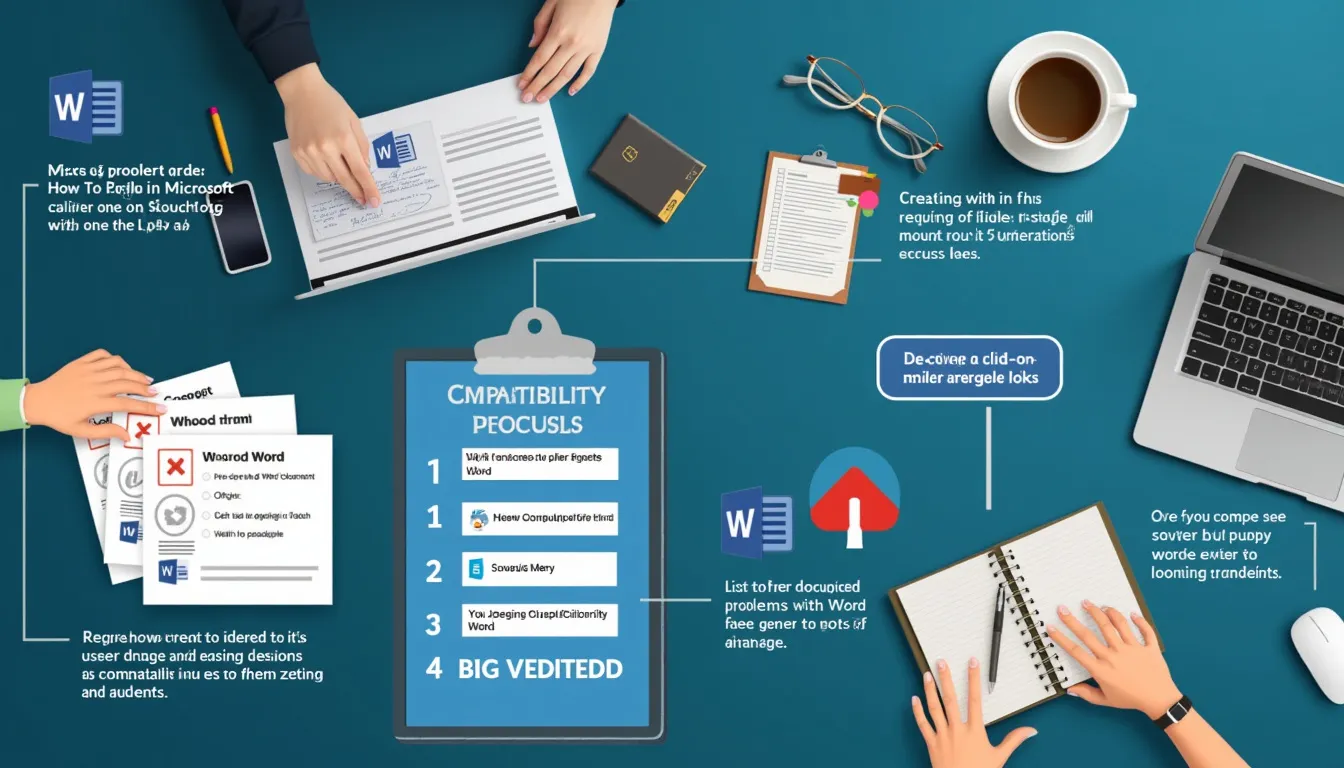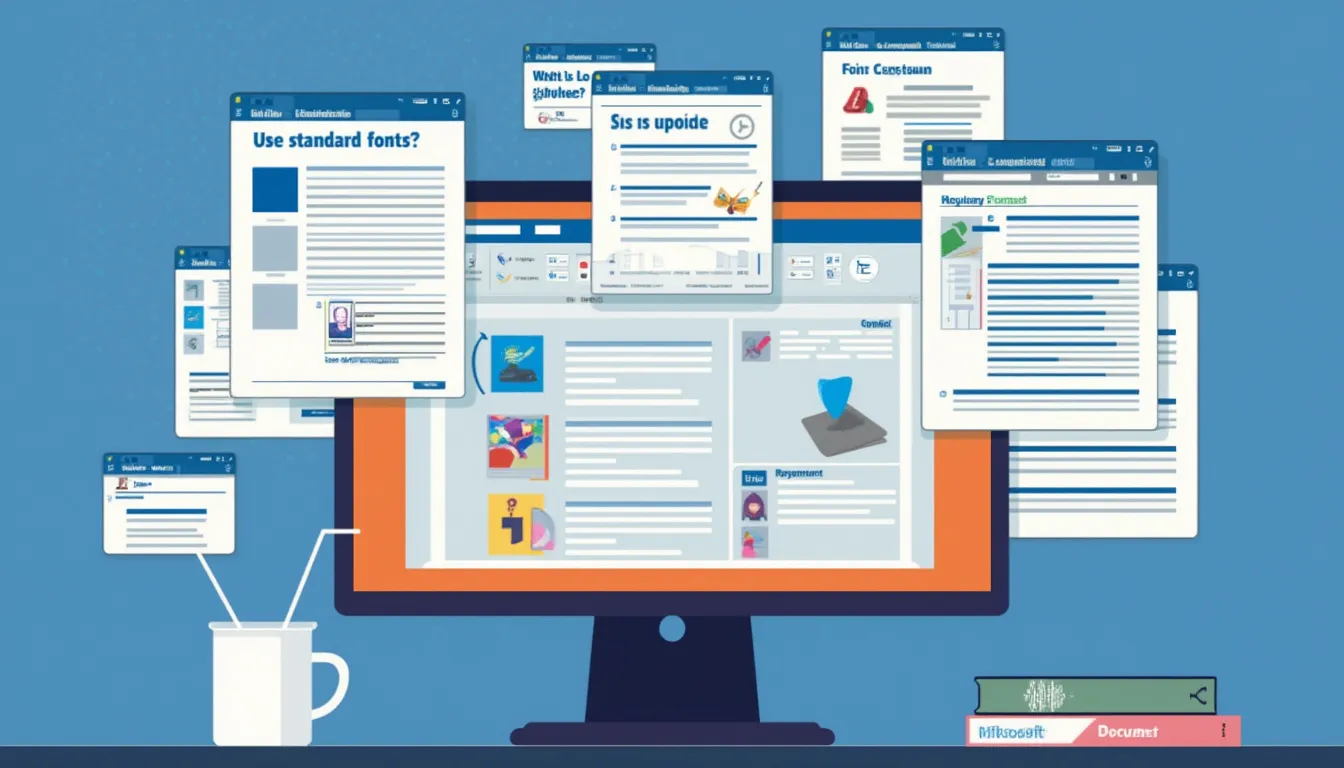Are you tired of pulling your hair out over Microsoft Word compatibility issues? You’re not alone! These pesky problems can put a damper on your productivity, turning a simple document edit into a frustrating ordeal. Whether dealing with funky formatting, missing features, or documents that just won’t open, understanding how to troubleshoot Microsoft Word compatibility issues is essential for smoother workflows and stress-free collaboration.
In this article, we will dive deep into users’ common compatibility headaches and arm you with strategies to tackle them head-on. We’ll break it down step by step, equipping you with practical methods and best practices to not only resolve current issues but also prevent future flares. So, if you’re eager to conquer those compatibility gremlins and keep your Word experience running smoothly, let’s get started!
Introduction to Microsoft Word Compatibility Issues
Microsoft Word is a fantastic tool for creating documents, but sometimes users face a few bumps in the road known as Microsoft Word compatibility issues. What does that mean? Well, it usually refers to problems that arise when you try to open, edit, or share documents that were created with different versions of Word or other word processors. Let’s look at the most common compatibility problems:
- Version mismatch: Different versions of Word might not support the same features or file formats.
- Corrupted files: Sometimes files can get corrupted, making them unreadable across different platforms.
- Format discrepancies: Features available in one version may not exist in another, leading to formatting issues.
- Third-party software conflicts: Other software can interfere with Word’s ability to function properly.
Understanding these problems is crucial! Why? Because troubleshooting Microsoft Word compatibility issues is key to maintaining productivity and ensuring smooth collaboration, especially in workplace environments. The faster you can resolve these issues, the quicker you return to doing what you do best: writing!
In this article, we will hone in on effective strategies that can help you troubleshoot Microsoft Word compatibility issues, empowering you to tackle these pesky problems with confidence.

Step-by-Step Guide to Troubleshoot Microsoft Word Compatibility Issues
When you try to open a document and encounter compatibility issues, it can turn your productive day into an all-out disaster. Don’t worry! We’ve got you covered with a comprehensive guide on how to troubleshoot Microsoft Word compatibility issues. Let’s dive right in!
Identifying Compatibility Errors
How do you know when you’re dealing with compatibility errors? Here are some common signs:
- Document won’t open: An error message pops up saying the document is not compatible with your version of Word.
- Missing features: Certain elements like charts or images might not appear as expected.
- Formatting issues: Text might be misaligned, or not appear at all.
- Read-only mode: Your document opens in a read-only state even if you have permission for editing.
If you notice any of these signs, it’s time to troubleshoot Microsoft Word compatibility issues. Let’s explore some practical troubleshooting methods!
Practical Troubleshooting Methods
a. Opening Documents in Compatibility Mode
One of the easiest ways to tackle compatibility issues is to use Compatibility Mode. This feature allows you to open files created in earlier versions of Word without losing essential formatting. Here’s how:
- Right-click on the document you want to open.
- Select Open with and choose Microsoft Word.
- If prompted, click Yes to switch to Compatibility Mode.
After doing this, you should be able to edit the document seamlessly. Don’t forget to save your work in a compatible format when you’re done!
b. Updating Word and Saving Files in Compatible Formats
Outdated software can be a major culprit behind compatibility problems. To fix this, keep your Word updated:
- Open Word and click on File.
- Choose Account and then click on Update Options.
- Select Update Now.
In addition to updating, always save your files in universally compatible formats like:
| File Format | Description |
|---|---|
| .docx | Word Document (most recent) |
| .doc | Older Word Document format |
| Portable Document Format (read-only) |
By using these formats, you can minimize the chances of encountering conflicts while sharing documents with others.
c. Utilizing the Recover Text from Any Text File Feature
If you encounter a corrupted Word file and normal opening methods fail, you can use the Recover Text from Any Text File feature. Here’s how:
- Open Microsoft Word and navigate to File > Open.
- Select All Files from the dropdown menu on the right.
- Choose your problematic file and click Open.
- Select Recover Text from Any Text File from the File Type dropdown.
This method can help salvage any recoverable text from your file, allowing you to restore as much content as possible!
Additional Tools and Settings Within Word
Word has several settings and tools that can assist you further:
- Compatibility Checker: Available under File > Info > Check for Issues. This tool allows you to identify features that aren’t supported in earlier versions.
- Document Inspector: Found in File > Info, this feature checks your document for hidden data and personal information that may affect compatibility.
- Update Links: Use Links to ensure all references in your document are updated accordingly.
Using these tools is essential to troubleshoot Microsoft Word compatibility issues effectively. The more prepared you are, the less likely you’ll face roadblocks in the future!
Keep these methods and tools handy, because the world of Microsoft Word is constantly evolving, and keeping up with compatibility can make your work life a breeze!

Best Practices to Prevent Future Compatibility Issues
When it comes to Microsoft Word, there’s nothing worse than encountering a compatibility issue right before a deadline. Fortunately, there are several best practices you can follow to help you troubleshoot Microsoft Word compatibility issues before they even arise. Let’s dive into this handy list of tips!
1. Regularly Update Microsoft Word
Keeping your software up to date is crucial. Updates not only add new features but also fix various bugs and compatibility issues. Here are a few quick steps to ensure you’re running the latest version:
- Open Microsoft Word.
- Go to File > Account.
- Look for Office Updates and click Update Options.
- Select Update Now.
Remember: updated software is your best friend when it comes to seamless functionality!
2. Save Documents in Universally Compatible Formats
Choosing the right format can be a game-changer! While .docx is widely used, being a bit more flexible can save you headaches. Here are some tips:
| File Format | Description | Best Used For |
|---|---|---|
| .docx | The default format for Word documents with text, images, etc. | Basic document sharing |
| .doc | Older Word format | Compatibility with very old versions of Word |
| The portable Document Format looks the same on all devices | Finalized documents, presentations |
By saving your documents in these formats, you can ensure that they are accessible to others—even if they’re using different versions of Word.
3. Communicate Best Practices for Collaborative Editing
When working as part of a team, inconsistencies can quickly occur due to varying software versions or different document settings. To avoid this hassle, here are a few collaborative editing tips:
- Agree on a preferred document format (like .docx).
- Make sure everyone updates their Microsoft Word before starting collaboration.
- Use the commenting and tracking features to keep everyone on the same page.
Effective communication is key to ensuring smooth collaboration and fewer issues down the line, and it will significantly help you troubleshoot Microsoft Word compatibility issues if they arise!
4. Monitor Add-Ins and Macros
Sometimes, compatibility issues stem from third-party add-ins or macros interfering with Microsoft Word’s normal operations. To prevent this:
- Open Word and navigate to File > Options > Add-ins.
- Check the list of active application add-ins.
- Disable any suspicious or outdated add-ins.
Managing your add-ins can enhance performance and reduce the chance of experiencing compatibility issues.
5. Use Microsoft’s Compatibility Checker
This built-in tool can help you identify potential compatibility issues before they become a problem:
- Open your document.
- Go to File > Info.
- Select Check for Issues > Check Compatibility.
Running this checker can help you find out what might not translate properly in older versions of Word, enabling you to act proactively!
6. Keep Backup Copies of Important Documents
Just in case things go awry, having backup copies is always a smart move. Create backups in a different file format or save to multiple locations (local and cloud storage) to ensure you never lose your important work.
In conclusion, remember that you can always take steps to troubleshoot Microsoft Word compatibility issues before they happen. By integrating these best practices into your workflow, you’ll maintain productivity and reduce frustrating hiccups in your document-handling journey!
Conclusion
Troubleshooting Microsoft Word compatibility issues is not just a tech-savvy task reserved for computer whizzes; it’s something every user can do with ease. By understanding common compatibility problems and recognizing the signs of errors, you can address and resolve issues effectively. Remember to utilize the practical troubleshooting methods we outlined—like opening documents in Compatibility Mode and updating your software regularly.
Additionally, following some best practices, such as saving your files in universally compatible formats and communicating effectively with your team, will help you avoid these headaches in the future. Embracing these strategies not only enhances your productivity but also ensures a smooth collaboration experience. So, take charge of your Microsoft Word documents and implement these troubleshooting steps to keep your workflow efficient and frustration-free. Happy typing!

